Introduction of the craft:
One of the most artistic and beautiful specimens of handicrafts, Kantha embroidery originated in Bengal and is one of the most prized possessions of the state and the women that reside there. 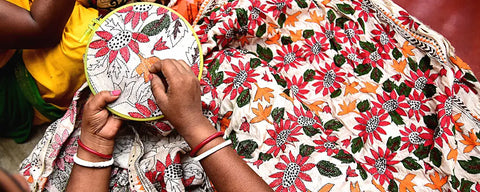
The name of the art translates to ‘patched cloth’ in English, and is accompanied by the Kantha is the epitome of skilled handwork, and is also one of the best examples of sustainability, as the cloth that is used is done by utilizing leftover textiles that would in any other scenario be used as rags or thrown away.
Details About Bengal Kantha Embroidery
There are two types of embroideries that are used, the first being old and discarded cotton sarees and dhotis and the other type was used by quilting and embroidering disposed cotton bedsheets, and enhancing them by making pictorial embroidery designs and done with Tussar silks. The thickness, length and size of the Kantha are varied according to its style and type. The expertise of Kantha embroidery. Several white threads are used to stitch together the layers of pieces and fabrics, and are drawn and procured from old sarees.
The initial step of the process is to draw and trace the pattern of the design onto the fabric and then fill it in with colorful thread materials that are also drawn from colors bordered by sarees.
Initially, the motifs used for Kantha embroidery came from inspiration from Portuguese and European traditions, but since then it has been widely practiced in places such as Hugli, Satagaon, Patna, Khulna, etc. Each piece of fabric is unique because the artisans express their creative talents and skills through the designs that they produce. They use new designs, motifs, and forms of art in each piece. But they can also be similar as they all stem from similar social and ecological backgrounds and hence can draw inspiration from similar aspects and points of view. There are also some basic traditional designs that are used for the fabrics, which are standard and regal in their own way, flashing their authenticity. 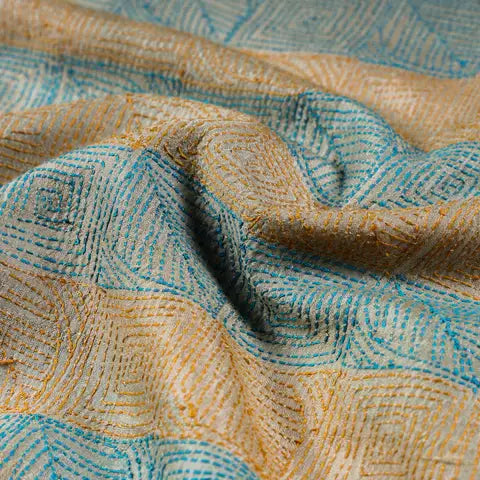
Needlework for this embroidery is very intricate and delicate, and is done by using the method of original draining stitch along with loop stitches and satin as well. These add a beautiful look to the cloth and give it a touch of expertise in stitches. There are two kinds of patterns or methods that are followed in the making process. 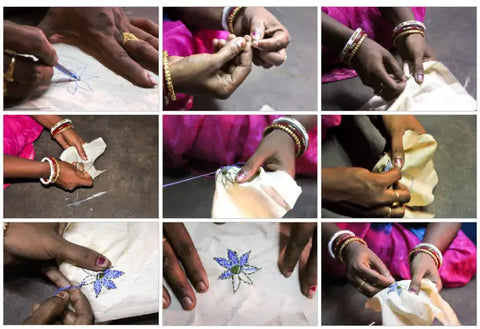
One of them is done by starting the embroidery process from the center to the ends of the design, and then filling in the motif, and the other is vice versa, where the stitches start from the end and go inwards. This kind of embroidery tends to give a textural and sensational effect to the fabric, and uses striking colors like blues, blacks, and red, which are all embodiments of various aspects of nature and Earth.
Some of the different styles of Kantha are Arshilata, Bayton, Burjani, Lep Kantha, Oar and Sujani. The larger and more obvious designs are used for bigger pieces of fabrics such as bed covers, curtains and canopies, whereas the smaller and more subtle motifs are used for sarees, personal items and pillow covers among others.
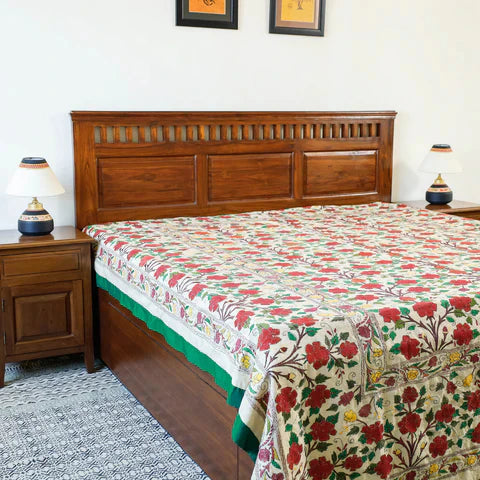
The Timeless Art of Kantha Embroidery and Its History
This traditional embroidery art is something unique. Unlike other embroidery handicrafts in India, Kantha threadwork uses old clothes. It is a way to give a new life to something which can be easily discarded. Rural women add a new life to rugs by turning them into usable material.
While doing so, they add beautiful patterns and motifs using a simple running stitch. However, it evolved into a decorative form with elaborate motifs. Artisans now use brightly coloured threads creating geometric shapes, flowers, and birds. It is a symbol of Indian heritage depicting natural beauty, folklore, and daily life through thread.
In recent years, the popularity of Kantha stitch has increased around the world. It is making a presence internationally not as a quilting fabric but in the form of wearable fashion. Jackets made by Kantha threadwork are in high demand. With the ongoing sustainable fashion trend, Kantha jackets are a sustainable craft. They are great for all seasons and styles. Apart from this, Kantha embroidery is also available on sarees, shawls, and shrugs. Rural women from the Bengal region indeed create magic turning rags into elegant, embroidered fabrics.
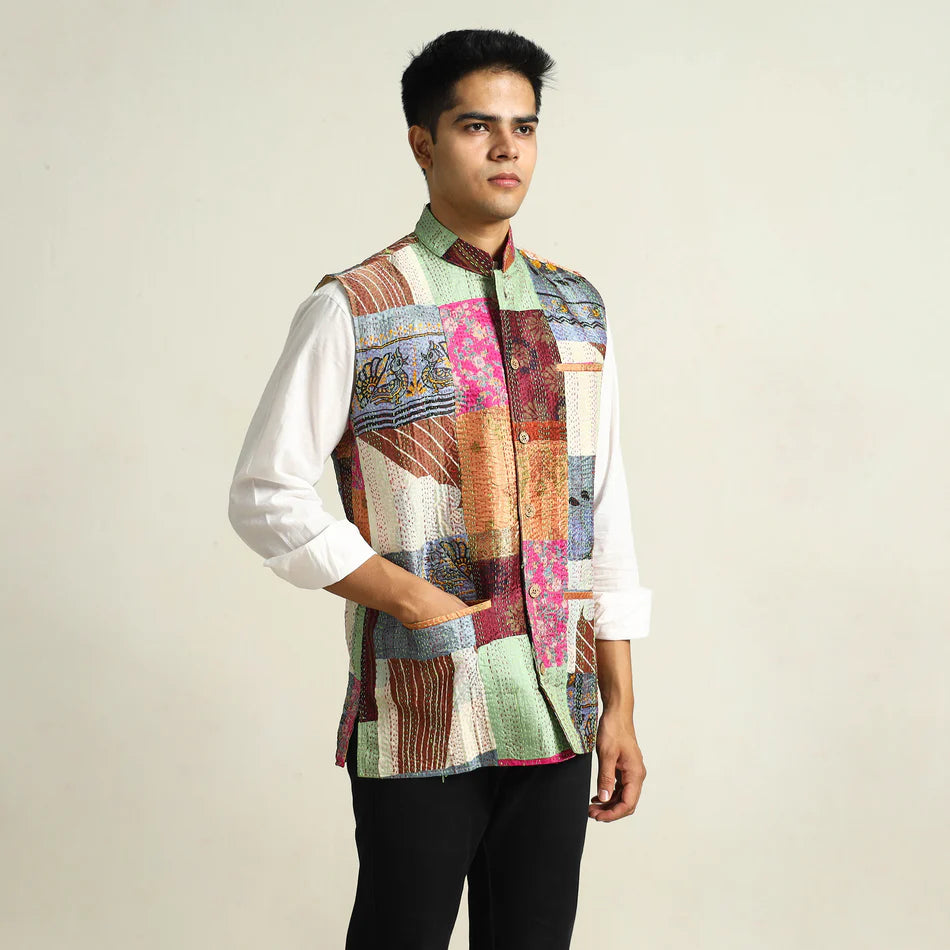
You can get a variety of Kantha stitch fabrics from online stores like iTokri. There are various jackets, blouses, dupattas, and dress materials for everyday use. Not only wearable fashion, but you can also get home décor items like a jewellery box, tissue box, and quilts.
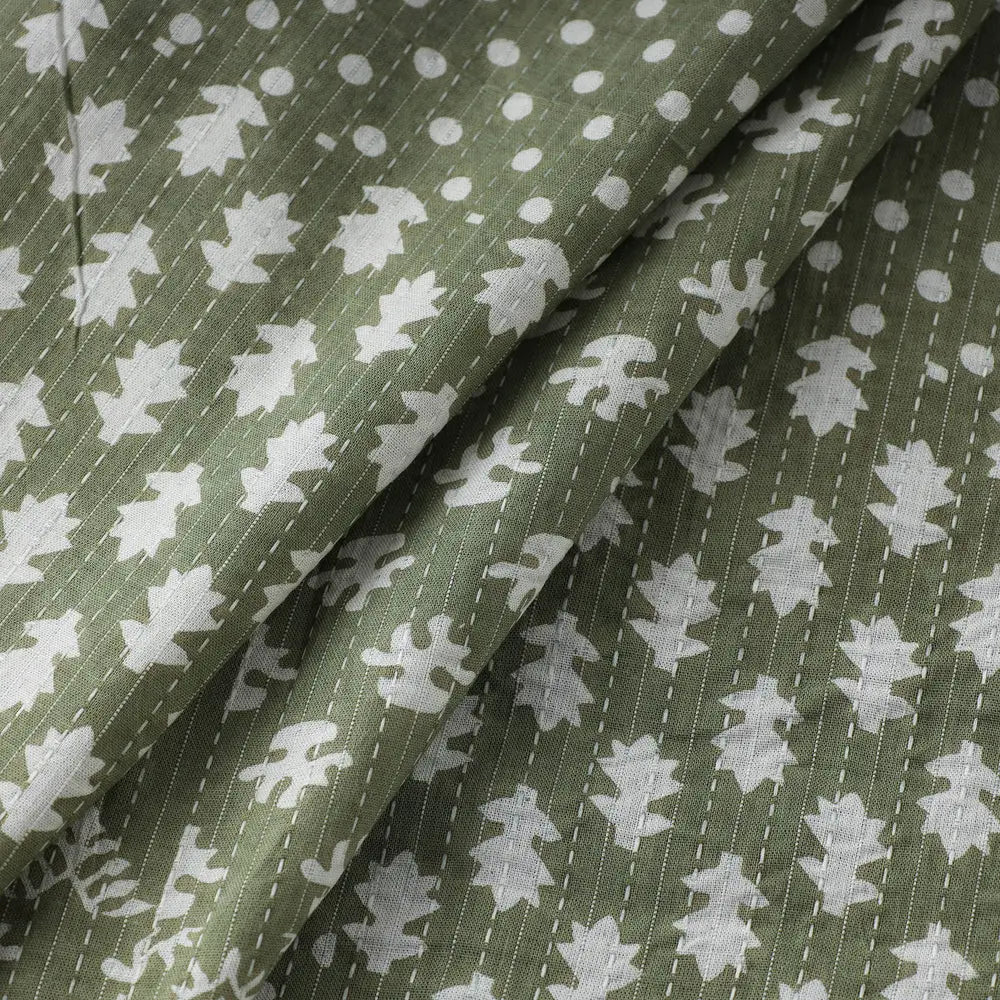
Exploring Unique Patterns and Techniques of Kantha Stitch
Originating in the rural areas of Bengal, India, Kantha embroidery is a unique threadwork. The stitches are simple, with a distinctive technique. Women sit together after finishing their housework, sing and create these simple patterns. They try to capture the natural beauty of Bengal through threads. There are various forms of stitches in this embroidery style.
Sada Kantha: This is the simplest form of Kantha stitch. In this form, minimal decorative elements are used while creating threadwork.
Lep Kantha: It is a form of layered embroidery work where multiple fabrics are placed together. It is used for making quilts from old fabrics with running stitches.
Sujani Kantha: This is the storytelling form of embroidery where Ramayana and Mahabharat are the themes. It also has lotus, bees, animals, and such elaborate embroidery.
Bodhna kantha: In this form of embroidery, geometrical and abstract patterns are used. Bright-coloured threads, circles, diamonds, and squares are created on fabric.
Apart from these, there is Angla Kantha, Durga Kantha, Bajan Kantha, and a few others. This ancient form of threadwork is passed down through generations. It is a great way to repurpose old fabrics and add life to it. Now, Kantha embroidery is used for creating home décor items and fabrics.
In this art form, simple stitches with bright-coloured fabric add contrast to the fabric. Sometimes a black thread outline with coloured patterns in between is used for making striking pieces. It is a simple yet captivating way of storytelling among rural women of Bengal and Orissa.
Interesting Facts: About Bengal Kantha Embroidery
One of the most interesting pieces of information behind this style of handiwork, and something that is of rare knowledge to most, is that the first factory made of Kantha embroidery was started in Pune, in the year 1920, and the fabrics first started getting manufactured in the year 1895.
Another less known fact is that Kantha is a type of embroidery that is projected on both sides of the fabric. The work is so professional and intricate that it is often very difficult to identify the front, or the right side of the cloth.
Future and Survival of the Bengal Kantha Embroidery handicraft:
In today’s modern world, there is a great demand for Kantha Embroidery in the textile industry and the latest fashion trends. There is large industrial manufacturing of the products and is a major source of income for those from the originating and neighboring villages that practice this.
A study shows that there is a level of entrepreneurial expertise that is inbuilt in the men and mainly women that have been practicing this art for generations, and there are multiple socio-economical logistics that are involved with the same.
Why Choose From iTokri:
iTokri has been one of the most avid supporters of this handicraft and its artisans, and have multiple different styles and products of the Kantha Embroidery. The sarees come in different colors, with varied motifs and exciting designs, which help the customers maintain a link with the tradition of the old textile industry and prestigious art forms. Some of these products are, 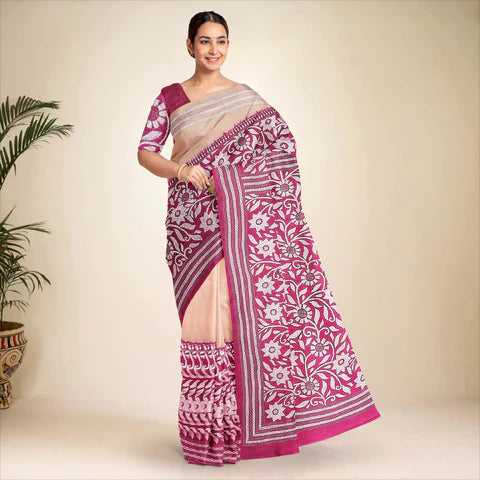
Bengal Kantha Embroidery Handloom Bangalore Silk Saree, Hand embroidered Pure Tussar Silks, Bengal Kantha Hand Embroidery Handloom Cotton Saree With Tassels, and Bengal Kantha Hand Embroidery Pure Handloom Ghicha Tussar Silk Saree, among a few
What makes Bengal Kantha Embroidery special?
The connection with tradition is one of the most significant features of Kantha. For years on end, the women of Bengal have been keeping the art alive, and practicing it, not only for economical benefits but as an ode to the past culture of the region. The motifs and designs that are stitched onto the fabrics are beautiful representations of nature and symbolize the elements of the same in a simple, but the grand manner, which enhances the fabric even more. The diversity of the bases that this can be designed on is another leading factor which make it more versatile, such as pure silk sarees, cotton handloom pieces, as well and handloom ghicha silk sarees, which can be worn for varied occasions. Vibrant colors mixed with elegant motifs are an attracting factor for the consumers of the products, and hence has helped keep this art afloat since its initiation.
FAQ Section
What is the Kantha embroidery?
In India, there are many forms of threadwork available and kantha is one of them. Also known as Bengal kantha embroidery, this is a simple form of threadwork. In this embroidery form, women use a running stitch style for creating traditional motifs. Popular among rural women from Orissa and Bengal, Kantha is a way to revive old fabrics. These rural women repurpose old clothes in the form of quilts adding prints on them. Kantha means a fabric or quilt. However, this sustainable art is now making its way into mainstream fashion.
Which state is famous for Kantha embroidery?
Kantha, also known as Kanta or Qanta originated in Bengal, India. This centuries-old art now prevails in Orissa and West Bengal which were part of the Bengali region. Over here you can get authentic kantha embroidery. Some of the popular styles of Kanta embroidery designs are Sujani, Baiton, Chatai, Lep and Nakshi. This distinctive running stitch is known for its simple yet captivating look. Local women use old fabrics and running stitches to repurpose them. Kantha threadwork is sustainable fashion in the true sense. This art is a significant part of Bengali and Oriya culture.
Blogs you might also like:
Pedna Kalamkari - In Conversation with Pitchuka Srinivas
Kahani of The 'Khandani' Banarsi Wooden Artery
Magnificent Pattachitra Paintings of Orissa
 Verified Purchase
Verified Purchase

































Leave a comment (all fields required)